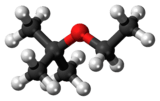Ethyl tert-butyl ether
 | |
 | |
| Names | |
|---|---|
| IUPAC name
2-Ethoxy-2-methyl-propane | |
| Other names
Ethyl tert-butyl ether Ethyl tertiary butyl ether Ethyl tert-butyl oxide tert-Butyl ethyl ether Ethyl t-butyl ether | |
| Identifiers | |
| 637-92-3 | |
| 3D model (Jmol) | Interactive image |
| Abbreviations | ETBE |
| ChemSpider | 11996 |
| ECHA InfoCard | 100.010.282 |
| EC Number | 211-309-7 |
| PubChem | 12512 |
| RTECS number | KN4730200 |
| |
| |
| Properties | |
| C6H14O | |
| Molar mass | 102.18 |
| Appearance | Clear colorless liquid |
| Density | 0.7364 g/cm3 |
| Melting point | −94 °C (−137 °F; 179 K) |
| Boiling point | 69 to 71 °C (156 to 160 °F; 342 to 344 K) |
| 1.2 g/100 g | |
| Hazards | |
| R-phrases | R11 R20 |
| S-phrases | S16 |
| Flash point | −19 °C (−2 °F; 254 K) |
| Except where otherwise noted, data are given for materials in their standard state (at 25 °C [77 °F], 100 kPa). | |
| | |
| Infobox references | |
Ethyl tert-butyl ether (ETBE) is commonly used as an oxygenate gasoline additive in the production of gasoline from crude oil. ETBE offers equal or greater air quality benefits than ethanol, while being technically and logistically less challenging. Unlike ethanol, ETBE does not induce evaporation of gasoline, which is one of the causes of smog, and does not absorb moisture from the atmosphere.
Synthesis
It is synthesized by mixing ethanol and isobutylene and reacting them with heat over a catalyst.
.png)
Ethanol, produced by fermentation and distillation, is more expensive than methanol, which is derived from natural gas. Therefore, MTBE, made from methanol is cheaper than ETBE, made from ethanol.
See also
- Methyl tert-butyl ether (MTBE)
- tert-Amyl methyl ether (TAME)
- Tetraethyl lead (TEL)
References
- ↑ Merck Index, 11th Edition, 3732.
External links
- ETBE Product Bulletin
- EC Joint Research Centre ETBE risk assessment report
- Directive 98/70/EC of the European Parliament and of the Council of 13 October 1998 relating to the quality of petrol and diesel fuels and amending Council Directive 93/12/EEC
- An assessment of the impact of ethanol-blended petrol on the total NMVOC emission from road transport in selected countries
This article is issued from Wikipedia - version of the 11/30/2015. The text is available under the Creative Commons Attribution/Share Alike but additional terms may apply for the media files.